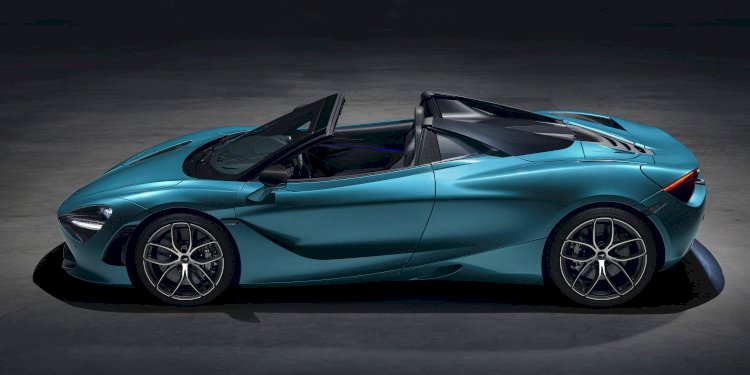McLaren 720S Spider
The new McLaren 720S Spider is the most accomplished convertible supercar ever from McLaren, combining the thrill of open-air driving with unparalleled Super Series dynamic performance and sophistication.
 Photo by McLaren Automotive Limited
Photo by McLaren Automotive Limited
The new 720S Spider delivers the exhilaration of open-air driving and levels of day-to-day usability unseen in the convertible supercar class.
"The new McLaren 720S Spider offers an unparalleled blend of extreme performance, crafted luxury, driver involvement and daily usability - all with the additional exhilaration of open-air driving whenever required. As the most accomplished convertible supercar ever, the new Spider delivers across a remarkable spectrum of abilities to outstandingly high levels, and as lightest in class with an increase of just 49kg over the 720S Coupé, moves us even further ahead of our competition in the weight race." said Mike Flewitt, Chief Executive Officer, McLaren Automotive
The design foundations of the new McLaren Spider are the seamless and organic forms introduced in 2017 with the 720S Coupé. Combining to maximise downforce, minimise drag, enhance powertrain cooling and optimise aerodynamic performance, these shapes produce an overall appearance akin to a futuristic sculpture, formed by the air that flows over, under, around and through it. A new, electrically actuated Retractable Hard Top (RHT) is seamlessly integrated into the design, as are new buttresses.
Carbon fibre core for strength and light weight
Like all McLaren cars, the new 720S Spider has a carbon fibre structure at its core, in this case designated Monocage II-S. The strength, rigidity and light weight of the McLaren Monocage is the base for the dynamic excellence for which McLarens are renowned. The Monocage II-S is a development of the Coupé ’s Monocage II, without the central ‘spine’ running front to rear above the cabin. The rearmost section of the upper structure is also unique to the Spider, to accommodate the Retractable Hard Top; additionally, the header rail across the top of the windscreen has been revised, to integrate the central latching mechanism.
McLaren’s engineering ingenuity, underpinned by the inherent strength and rigidity of carbon fibre, means that despite the removal of the fixed roof there is no need for additional strengthening; even the unusually slim but incredibly strong windscreen A-pillars first seen on the 720S Coupé remain. To provide enhanced rollover protection for occupants, fixed carbon fibre structural supports are integrated into the rear of the Monocage II-S, additionally providing the main anchor points for the roof system and the seatbelts. In the first-generation Super Series, steel supports featured and the switch to carbon fibre has contributed to the Rollover Protection Structure (ROPS) in the 720S Spider being 6.8kg lighter than in the 650S.
Overall, the new 720S Spider is just 49kg - or less than 4% - heavier than the 720S Coupé. The increased weight is primarily associated with the RHT and tonneau system. With a lightest dry weight of 1,332kg the 720S Spider is comfortably the lightest car in its competitive set, at 88kg less than the 1,420kg dry weight of its closest rival. The low weight is the foundation for the dynamic, performance and efficiency benefits that McLaren is so adept at exploiting for the greater enjoyment of its customers.
Unique glazed flying buttresses aid rear visibility, enhance visual drama
The canopy-like design of the 720S Coupé is recognised for the sense of 360-degree vision it provides, allowing light to flood into the cabin and setting a new benchmark for visibility. This philosophy of unrivalled vision is central to the second-generation Super Series and the new Spider moves the game on again, with unique, glazed flying buttresses further aiding driver visibility as well as adding visual drama to the car.
The leading edge of the buttress features an aerodynamic carrier to guide airflow, before dramatically tapering off to expose darkened glazing; the design and the use of glass delivers a 12% improvement in over-the-shoulder visibility compared to the previous McLaren Super Series Spider.
To accommodate the Retractable Hard Top, the Monocage II-S features a new carbon fibre upper structure engineered to sit as close as possible to the air charge coolers and intake plenum. This maximises luggage space; there is 58 litres of stowage available under the tonneau cover with the roof raised. The tonneau cover also sits lower than that of a 650S Spider - again by 25mm - extending visibility by 7.5m in length.
Three specifications, two new exterior colours, return of one heritage colour
The new 720S Spider is available in the same three specifications as the Coupé, with Performance and Luxury trims extending above the standard model. Two new exterior colours - Belize Blue and Aztec Gold - have been introduced for the new Spider among a palette of 23, one of which is Supernova Silver, a Heritage colour that was first available on the McLaren 12C.
The McLaren 720S has established a reputation in Coupé guise for its ground-breaking design, cutting-edge technologies and ferocious pace, complemented by a breadth of ability and sophistication that delivers everyday usability belying its extreme performance status. The new 720S Spider, which is available to order now from 237,000 GBP, is the equal of the Coupé in every respect.
Find more Cars
50 Years of the Porsche 914
An eye-catching original turns 50, with the 914, Porsche was the first Germ...
5 things about Lamborghini you did not know
5 things about Lamborghini you did not know; From the lowest Lamborghini to...
Audi RS 5 Coupé
The new Audi RS 5 Coupé is the first Audi Sport model in the new RS design ...
The Audi e-tron GT concept
A Four-door Gran Turismo with an electric drive with a flat-floor architect...
Pagani presents the Zonda Revolucion
Limits are made to be overcome. We knew it would be very difficult to desig...
Maserati MC20 Icona & MC20 Leggenda
Maserati's racing vocation brings to life the MC20 Icona and MC20 Leggenda,...




















